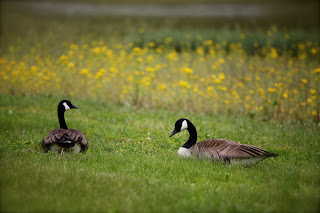a statement of ownership,
laws placed upon a piece of land,
markers of and for those who go there.

we own nothing beyond ourselves.


 See more Skywatch here.
See more Skywatch here.
I love to see the surface of a lake, smooth as glass--
unbroken by nothing more than my reflection, gazing over it.
A field of grass in the morning,
still beneath the silver sheen left by last night’s moon—
the clear sky, cold and dark.
No steps yet there--mine alone to enjoy.






Each morning, we gathered for breakfast under a small shelter at the edge of a nearby park. In the dark and dense fog, heavy eyes scanned only as far as the tables, set with food—and a coffee station doling out warmth, and life, to the 6:00 a.m. crowd.
By afternoon, on our return here, this large cedar beside the structure was catching the full midday sun—illuminated all across its great size.
And, orange balls, glowing. It’s Cedar-Apple Rust.
It’s Cedar-Apple Rust.
And these great fingers, telia, extending from the purple knobs on every branch, reminded me of playdough squeezed through a child’s toy, extruded in long, cool, floppy forms.
This wet spring prompts them forth. From them, the bright orange teliaspores will be carried, on a breezy day, to find an apple or quince tree nearby. In the fall, from lesions there, aecia, growing on the apple’s leaves and fruit, aeciospores are blown, back to cedar again—the cycle between the two plants completed in 24 months.
From them, the bright orange teliaspores will be carried, on a breezy day, to find an apple or quince tree nearby. In the fall, from lesions there, aecia, growing on the apple’s leaves and fruit, aeciospores are blown, back to cedar again—the cycle between the two plants completed in 24 months.
This tree is heavy beneath them.
Their soft, gelatinous strands, bending the branches low.
But I find something very strikingly beautiful about them.
Orange balls of fire.
It’s the places, small in name, immense in value, that intrigue me.
Places like fens, and bogs, where the lives evolved within are rare.
Worlds unto themselves,
remnants from ages past--
these are true treasures to explore. The Cranberry Glades sit high within the Allegheny mountains of the Monongahela National Forest, bounded as a bowl at an elevation that allows this rare community, resembling arctic tundra, to exist as far south as Pocahontas County, West Virginia.
The Cranberry Glades sit high within the Allegheny mountains of the Monongahela National Forest, bounded as a bowl at an elevation that allows this rare community, resembling arctic tundra, to exist as far south as Pocahontas County, West Virginia.





 See more Skywatch here.
See more Skywatch here.
 Come along in Red Canoe as she explores the quiet backwater of Ohio's State Parks and the scenic streams and rivers of the Midwest. Discover the beauty hidden beyond the water's edge, quietly waiting, past access points, often only inches deep!
Come along in Red Canoe as she explores the quiet backwater of Ohio's State Parks and the scenic streams and rivers of the Midwest. Discover the beauty hidden beyond the water's edge, quietly waiting, past access points, often only inches deep!





 Come browse my photography site, Nature Remains: nothing but a photograph, for full-page slide shows of my favorite images and opportunities to purchase them.
Come browse my photography site, Nature Remains: nothing but a photograph, for full-page slide shows of my favorite images and opportunities to purchase them.
 In Spring of 2008, I began the study of 2 vernal pools on my property as part of the Ohio Vernal Pool Partnership monitoring program.
My 2008 journal includes the first photos and findings, as I studied this fascinating wetland area just a few steps beyond my backdoor...
In Spring of 2008, I began the study of 2 vernal pools on my property as part of the Ohio Vernal Pool Partnership monitoring program.
My 2008 journal includes the first photos and findings, as I studied this fascinating wetland area just a few steps beyond my backdoor...
 2009 photos and findings,
2010,... again!
Now, 4 years later, another season is just days away!
2009 photos and findings,
2010,... again!
Now, 4 years later, another season is just days away!

 Travel beyond the Midwest has taken me to some beautiful places. Usually off the beaten track, these places are WILD!
Acadia National Park
Travel beyond the Midwest has taken me to some beautiful places. Usually off the beaten track, these places are WILD!
Acadia National Park
 New River Nature Festival
New River Nature Festival
 Olympic National Park
Olympic National Park
 Pictured Rocks and the UP
Pictured Rocks and the UP
 Voyageurs National Park
Voyageurs National Park
 (click on the text above each photo for a quick get-away)
(click on the text above each photo for a quick get-away)
 A regularly appearing feature, "Have you seen..." takes a closer, more patient look at things usually not seen in a flattering light.
Take a look!
A regularly appearing feature, "Have you seen..." takes a closer, more patient look at things usually not seen in a flattering light.
Take a look!
 Each spring, as winter lessens its grip and days warm with the first fragrant breezes of a new season, we collect sap from our Sugar Maples and produce just enough syrup for ourselves for the coming year.
The progress of this year's backyard endeavor is illustrated here.
Each spring, as winter lessens its grip and days warm with the first fragrant breezes of a new season, we collect sap from our Sugar Maples and produce just enough syrup for ourselves for the coming year.
The progress of this year's backyard endeavor is illustrated here.
 Summer 2008, the tiny jewel of the avian world, a Ruby-throated Hummingbird, nested just feet from my front door. Pictures of her nest and the changing lives within are collected in this journal.
From life the size of a pea....
Summer 2008, the tiny jewel of the avian world, a Ruby-throated Hummingbird, nested just feet from my front door. Pictures of her nest and the changing lives within are collected in this journal.
From life the size of a pea....
 Cats that come to stay
Cats that come to stay
 (click on the text above each photo for stories in these collections)
(click on the text above each photo for stories in these collections)



Two roads diverged in a wood, and I-- I took the one less traveled by, And that has made all the difference.~Robert Frost